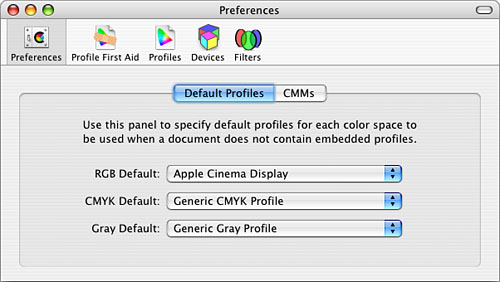Synchronizing Color Among Devices
One of the most challenging aspects of creating color documents for output on paper or electronically is maintaining consistent color among the images and text in those documents. Each device you use, such as monitors, printers, scanners, cameras, and so on, can have a slightly different interpretation of particular colors and can use a different color space. This makes creating a document that contains the colors you really want difficult.
Apple's ColorSync technology is an attempt to solve this problem. With ColorSync, you configure a ColorSync profile for each device with which you work. If all your devices use a ColorSync profile, the colors across the elements of your document should be consistent because ColorSync translates colors across different color spaces.
The two general steps to use ColorSync are the following:
Use the ColorSync Utility to select and configure a ColorSync profile for each device you will use.
Use the color management features of the application you want to use to create a document to select the ColorSync workflow for that project.
Configuring ColorSync
To configure a ColorSync profile for your devices, do the following:
NOTE
To use ColorSync, a device must have a ColorSync profile installed. For many devices, this profile is built in to Mac OS X. For others, the profile is installed when you install software related to that device.
Open the ColorSync Utility (Applications/Utilities).
Click the Preferences button if it isn't selected already, and then click the Default Profiles tab (see Figure 23.22).
Figure 23.22. Use ColorSync to match the colors on various devices with which you work.

Use the pop-up menus to select default profiles for the RGB, CMYK, and Gray color spaces. If you can't find the profile for the device you are using, you need to install its ColorSync profile or select a generic profile.
Click the CMMs tab and select the color-matching method you want to use. If you haven't installed additional CMMs, your choices are Automatic or Apple CMM.
To see the profiles installed, click the Profiles button and expand the area, such as System or Computer, to see the profiles that have been installed for that area.
To see the devices for which ColorSync profiles have been installed, click the Devices button and expand each type of device listed in the window (see Figure 23.23). You can select a device to see more detailed information and configuration options in the right side of the window.
Figure 23.23. This machine has several ColorSync profiles installed for various devices.

Click the Filters button to view and configure ColorSync filters.
Quit the ColorSync utility.
TIP
The Profile First Aid tab enables you to verify and repair the profiles installed on your Mac.
If you can't find profiles for the devices you want to use, see "I Don't See a ColorSync Profile for My Device" in the "Troubleshooting" section at the end of this chapter. |
NOTE
Understanding and using ColorSync effectively is a very complex topic. For detailed information, see Apple's ColorSync Web site located at www.apple.com/colorsync. |
Using ColorSync
After you have installed and configured your device profiles and workflows, the way you use ColorSync depends on the particular applications you use. For example, you can employ the ColorSync profiles when you print a document by using the ColorSync option on the Options pop-up menu in the Print dialog box. Other applications, such as Photoshop, enable you to employ more sophisticated ColorSync features.







